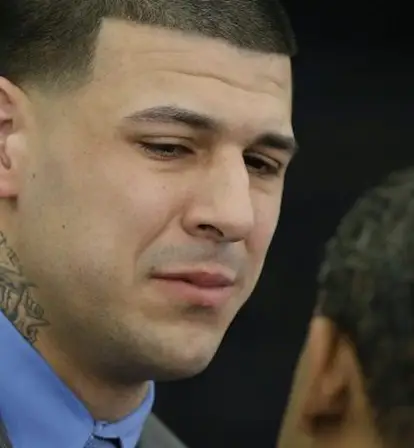On April 19, 2017, Aaron Hernandez died by suicide inside his Massachusetts jail cell — but what caused the former football star to take his own life?

Getty ImagesFormer NFL star Aaron Hernandez died by suicide in his cell at Souza-Baranowski Correctional Center in Lancaster, Massachusetts at age 27 on April 19, 2017.
Before Aaron Hernandez’s death in 2017, he was a world-class athlete who received the largest signing bonus ever given to an NFL tight end — $12.5 million — which went a long way to giving him the kind of life that most people can only ever dream about.
By his mid-20s, Hernandez was living in a $1.3-million mansion in Florida with his fiancée, Shayanna Jenkins, and their newborn baby daughter, Avielle. He seemed to have it all.
Yet despite looking like a quintessential American success story, behind the scenes, Aaron Hernandez’s world had been spiraling out of control since his father died when he was 16. The privilege and fame that came with his superstar status only exacerbated Hernandez’s crisis, culminating in Hernandez’s killing of Odin Lloyd in 2013 and his subsequent murder conviction two years later.
Then, in 2017, Aaron Hernandez died by suicide in his Massachusetts prison cell at age 27, hanged by the sheets off his bed — and his death left behind difficult questions that may never be fully answered.
How Aaron Hernandez’s Meteoric Rise Hid The Turmoil In His Life
Aaron Josef Hernandez was born on Nov. 6, 1989, in Bristol, Connecticut. Both he and his brother Jonathan were regularly abused — both physically and emotionally — by their alcoholic father. Jonathan Hernandez wrote in his book The Truth About Aaron: My Journey to Understand My Brother that Aaron Hernandez also suffered sexual abuse when he was just six years old at the hands of two older boys.
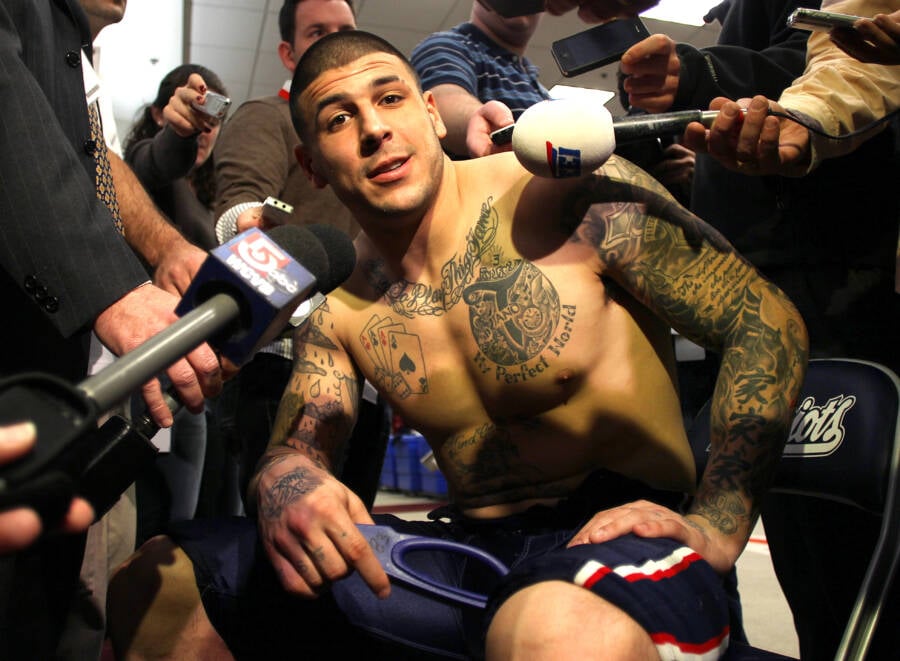
John Tlumacki/The Boston Globe/Getty ImagesNew England Patriots tight end Aaron Hernandez after practice on Jan. 27, 2012, in Foxborough, Massachusetts. He would be arrested and charged with murder the following year.
While it would appear that both boys could use football to bring some stability into their volatile situation, Aaron Hernandez’s dedication to the game likely amplified his emotional distress once he began to suffer brain injuries on the field. And it possibly set him on the path to a CTE-related psychosis that ultimately destroyed his life and the lives of those around him.
Yet signs of Hernandez’s violent temperament emerged early on in his career. As a 17-year-old freshman at the University of Florida, Hernandez got into a bar fight over a $12 bar bill, resulting in the bartender suffering from a ruptured eardrum. University of Florida lawyers managed the situation, and Hernandez’s prosecution on the assault charges was indefinitely deferred.
Hernandez’s problematic behavior quickly escalated. In 2007, police in Gainesville, Florida investigated Hernandez as a possible assailant in a double shooting on the night of Sept. 30. Randall Cason, Justin Glass, and Corey Smith were sitting in a car at a red light when an assailant approached and opened fire, wounding Smith and Glass. Both survived the attack.
Cason initially picked Hernandez out of a lineup but later recanted, saying he never saw Hernandez at the scene. Hernandez was never charged in the shooting, and the fact that he was considered a minor at the time kept his name out of press reports on the shooting.
Aaron Hernandez played successful college football and got the attention of the New England Patriots, who drafted him in the fourth round — 113th overall — of the 2010 NFL draft. If Hernandez saw his success as a chance to keep on the right side of the law, he appears not to have taken it, finding himself implicated in a double homicide in 2012.

Yoon S. Byun/The Boston Globe/Getty ImagesAaron Hernandez in Attleboro District Court on July 24, 2013, in Attleboro, Massachusetts, one month after being arrested as a suspect in the murder of Odin Lloyd.
On July 16, 2012, Daniel Jorge Correia de Abreu and Safiro Teixeira were shot and killed in their car while driving home from a nightclub in Boston’s South End. Witnesses said they saw Hernandez pull up beside the victims’ car and fatally shoot Abreu and Teixeria several times while also attempting to hit others in the vehicle.
Though he would eventually be indicted on first-degree murder charges in the killings, those charges would catch up with Hernandez after he had already begun his fall from NFL stardom. In the end, Hernandez would be acquitted of these charges, owing mainly to a bungled crime scene investigation that resulted in no physical evidence being introduced at Hernandez’s trial.
But by that point, the end had already come for Aaron Hernandez.
The Inexplicable Murder Of Odin Lloyd That Led To The Suicide Of Aaron Hernandez

NetflixThough some believe that Aaron Hernandez killed Odin Lloyd to cover up the truth about several other murders, the motive for this killing remains uncertain.
The crime that would ultimately lead to Aaron Hernandez’s death by suicide came in 2013 with the execution-style murder of Odin Lloyd, a semi-professional football player in Boston and the boyfriend of Hernandez’s fiancée’s sister.
Hernandez first met Lloyd at a family function hosted by Shaneah Jenkins, Lloyd’s girlfriend and the sister of Hernandez’s fiancee, Shayanna. The two men shared a passion for football and became friends.
On June 14, 2013, Hernandez and Lloyd visited a Boston nightclub where Hernandez saw Lloyd talking with several club patrons who Hernandez considered his “enemies.” Investigators believe that Hernandez suspected Lloyd and this group were discussing the 2012 murders of Abreu and Texeira. The conversation set in motion a tragic chain of events that would ultimately end the lives of both men.
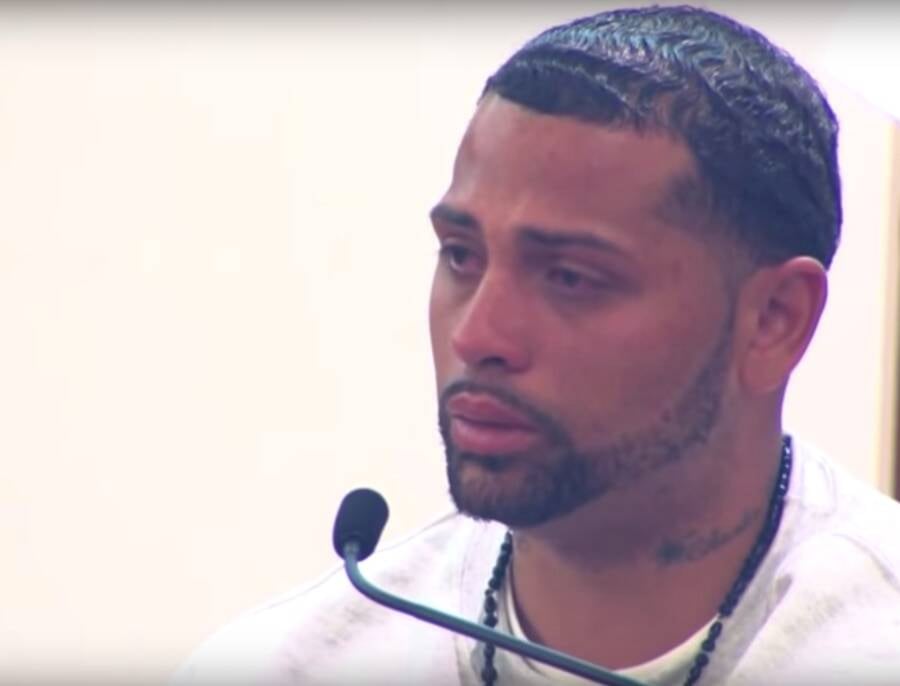
YouTubeCarlos Ortiz (pictured here) and Ernest Wallace were both found guilty of being accessories to murder after the fact. They each received four-and-a-half to seven years in prison.
Soon afterward, Aaron Hernandez texted two out-of-town friends, Ernest Wallace and Carlos Ortiz, that he could no longer trust anyone. Wallace and Ortiz came to Hernandez’s home, and Hernandez grabbed a gun and got in their car.
The men picked up Lloyd at around 2:30 a.m. on June 17, 2013. It was the last time Lloyd would be seen alive. Sensing that the situation was potentially dangerous, Lloyd texted his sister that morning that he was with “NFL,” adding, “Just so you know.”
Workers in an industrial park a mile away from Hernandez’s home found Odin Lloyd’s body with five gunshots to the back and chest. Lloyd’s text to his sister and the fact that his body was found so near to Hernandez’s house made the NFL star an immediate suspect.
Investigators turned up video evidence of Hernandez carrying the same type of gun used to kill Lloyd on the morning of the 17th. Boston police arrested Aaron Hernandez just nine days later, on June 26, 2013, and charged him with the first-degree murder of Odin Lloyd.
Though he would escape conviction on the 2012 murder charges in the Abreu and Texeira case, Aaron Hernandez’s luck ran out when a jury convicted him of the murder of Lloyd and sentenced him to life in prison without the possibility of parole on April 15, 2015.
Why Aaron Hernandez’s Death Leaves More Questions Than Answers
Just over two years after his conviction and sentencing, Aaron Hernandez died in his cell at the Souza-Baranowski Correctional Center in the early morning hours of April 19, 2017. He was just 27 years old.
“Mr. Hernandez hanged himself using a bedsheet that he attached to his cell window,” the Massachusetts Department of Correction said. “Mr. Hernandez also attempted to block his door from the inside by jamming the door with various items.”

Barry Chin/The Boston Globe via Getty ImagesAaron Hernandez and New England Patriots quarterback Tom Brady talk on the sidelines during a game against the Philadelphia Eagles at Lincoln Financial Field in Philadelphia on Nov. 27, 2011.
Aaron Hernandez’s death came on the same day that his former New England Patriot teammates were scheduled to visit the White House to celebrate their recent Super Bowl victory.
All Hernandez left behind were three suicide letters and a trove of transcribed prison phone calls that were subsequently published by The Boston Globe.
His fiancée revealed that, after Aaron Hernandez’s death, she learned he was bisexual and that he felt intense pressure to keep this part of himself hidden from the world.
“I wish I had known how he felt just so we could have talked about it,” she said. “I wouldn’t have disowned him. I would have been supportive. I can’t fault him if he was feeling that way… The fact that he couldn’t come out to me or he couldn’t tell me these things hurts.”
Aaron Hernandez’s suicide notes point to a man who was suffering greatly. They expressed a longing to bring an early end to his life sentence, even if it meant taking his own life. He hoped that doing so would let him enter a “timeless realm” beyond death:
“Shay,
You have always been my soul-mate and I want you to love life and know I’m always with you. I told you what was coming indirectly! I love you so much and know are an angle. We split into two to come change the world! Your characteristic is that of a true angel and the definition of God’s love! Tell my story fully but never think anything besides how much I love you. This was the supreme almightys [sic] plan, not mine! I love you! Let Avi know how much I love her! Look after Jano and Eddie for me — they are my boys (You’re Rich).”
Hernandez also wrote about the dangers of worshipping false idols, not having much time left, and that he would await his daughter in Heaven. His suicide notes were later released to Hernandez’s lawyer, Jose Baez, who subsequently wrote a book about Hernandez’s case.
The great question surrounding the fall and death of Aaron Hernandez remains an open one: what was it that ultimately derailed his life when he seemed to have achieved what most can only aspire to in dreams?
Inside The Mind Of Aaron Hernandez And Why He May Have Killed Himself
Aaron Hernandez’s suicide came before the appeal of his conviction was decided, so according to a doctrine in Massachusetts known as abatement ab initio, Hernandez’s murder conviction was officially rescinded — a move that sparked considerable pushback from prosecutors and the public. However, in 2019, Massachusetts’ highest court overturned the doctrine, at which point any rescinded convictions, including Hernandez’s, were reinstated.
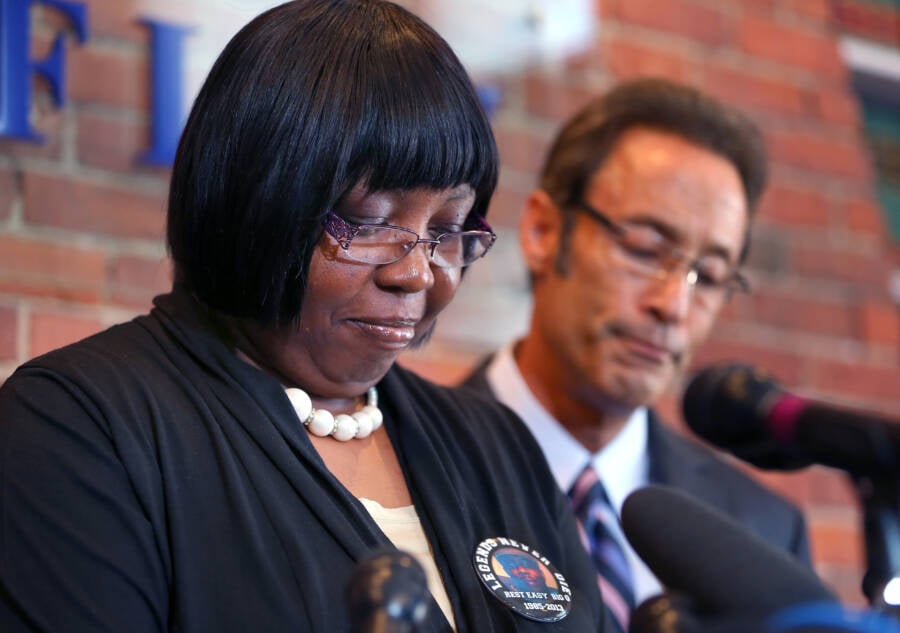
John Tlumacki/The Boston Globe via Getty ImagesUrsula Ward, Odin Lloyd’s mother, during a press conference on April 22, 2015.
“We are pleased justice is served in this case,” Bristol County District Attorney Thomas M. Quinn III said on Twitter at the time. “The antiquated practice of vacating a valid conviction is being eliminated and the victim’s family can get the closure they deserve.”
As for Hernandez’s criminal motivations or the psychological issues that led to them, the growing evidence of a link between chronic traumatic encephalopathy (CTE) and violent behavior and psychosis makes the question of Hernandez’s culpability in his crimes cloudier than many would like.
Dr. Ann McKee, a neuropathologist specializing in CTE at Boston University, was permitted to examine Aaron Hernandez’s brain after his death, and what she found was shocking.
According to NPR, she said she’d never seen an athlete under the age of 46 with as much CTE-related brain damage as she found in Aaron Hernandez’s. The effect that this damage had on any given specific aspect of Hernandez’s behavior is hard to isolate, but to believe that it was not a contributing factor — if not an overwhelming factor — in his decision to murder Odin Lloyd cannot be ignored.
This uncomfortable question and others are explored in detail in the Netflix documentary series on the life and murder trial of Aaron Hernandez, Killer Inside: The Mind Of Aaron Hernandez.
Then, in 2023, phone calls that Aaron Hernandez made just hours before his death came to light. However, the phone calls (though heavily redacted before release) show Hernandez in an upbeat mood, leaving the story surrounding his death as murky as ever.
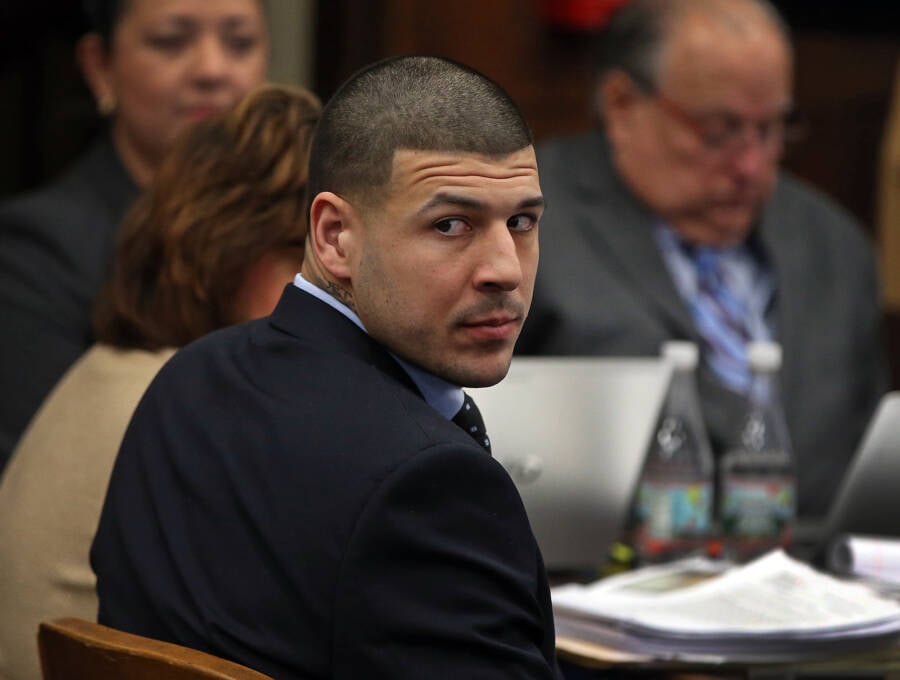
Nancy Lane/MediaNews Group/Boston Herald via Getty ImagesAaron Hernandez during his trial for the 2012 murders of Daniel de Abreu and Safiro Furtado, who he encountered in a Boston nightclub, on April 5, 2017. Hernandez died by suicide in his jail cell just two weeks later.
In the end, Hernandez wasn’t unaware of his mental health issues, though he largely blamed his mother for the downturn he saw in his late 20s, reportedly telling her that he “was the happiest little kid in the world, and you fucked me up.”
His brother, Jonathan Hernandez, maintains that the situation the two siblings lived through was much more complicated than any single event or person.
Because of Aaron Hernandez’s abusive home life and the traumatic brain injuries he sustained on the field, it is impossible to pinpoint any one factor or person as the lynchpin in the story of Aaron Hernandez’s spectacular rise to stardom and his shocking descent into murder — let alone find a reason for Aaron Hernandez’s death by suicide.
In the end, we may not even be able to pin the blame entirely on Aaron Hernandez either, leaving a frightening unknown hanging over the chronically-traumatized heads of every football player in America.
If you or someone you know is contemplating suicide, call the National Suicide Prevention Lifeline at 1-800-273-8255 or use their 24/7 Lifeline Crisis Chat.
After learning about the Aaron Hernandez’s death, take a look at history’s 11 most famous suicides, from artists to politicians. Then, learn about the fact that more U.S. veterans have died by suicide in the last 10 years than died in the Vietnam War.
